Fifty years ago, in 1972, came the release of the first Royal Oak watches from Audemars Piguet, designed by none other than Gerald Génta. The story of the Royal Oak is the stuff of legend (so I won’t delve into it here): a ground-breaking watch for its time which went on to help create an entirely new concept within watchmaking, the luxury sports watch with an integrated bracelet.
At a time when the accepted “norms” for luxury watches were smaller size diameters made in precious metals such as gold, Audemars Piguet went in the complete opposite direction with the Royal Oak. It was a larger size at 39mm, with a prominent octagonal bezel with visible hexagonal screws, with an integrated bracelet to boot. But the biggest talking point was that it was made from steel – never before had a watch forged from stainless steel been this expensive.
Heads were turned, and I’m sure eyes were rolled, too.
Little did Audemars Piguet know that this Royal Oak would go on to become what can only be described as an horological icon. Despite spawning an entire genre of watches, throughout its 50-year history the Royal Oak has stood the test of time, with its design rarely straying far from Genta’s vision, if at all.
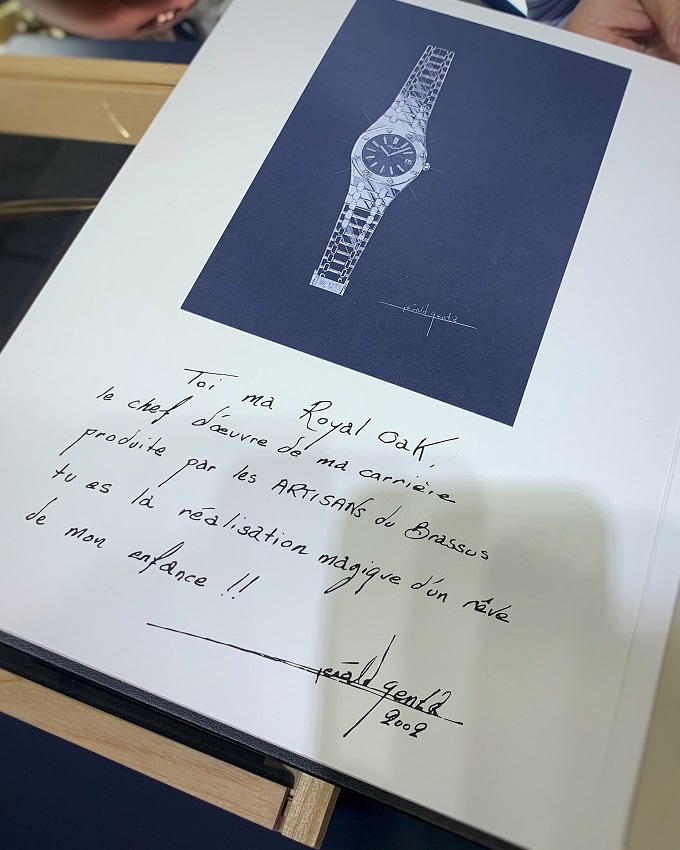
This year marks the 50th anniversary of the Royal Oak, and Audemars Piguet have already celebrated this by releasing several watches which, for this year only, will have a special limited edition ’50 years’ rotor visible through the sapphire caseback. I’m sure this will prove to be just the beginning of what is in store over the year – after all, the watch industry rarely passes up an opportunity to celebrate an anniversary!
In March of this year, in collaboration with Harrods in London, Audemars Piguet announced that they would be hosting a pop-up Royal Oak exhibit entitled “The Royal Oak: From Iconoclast to Icon” between 5th – 30th April 2022. Given neither Harrods or Audemars Piguet are one to do things in half-measures, I suspected that it would be worth a visit… and it most certainly was!
“The Royal Oak: From Iconoclast to Icon” Exhibit by Audemars Piguet at Harrods

Royal Oak Exhibit at Harrods, London
Approaching the exhibit, my first impressions were that there had clearly been a great deal of effort put into the displays; the raised floor was decorated with a tapisserie design reminiscent of the Royal Oak dials, whilst full-length mirrored pillars served to reflect the contemporary designs of the floor and walls, making the exhibit area feel both more spacious and separate from the busy Harrods walkway.
At the far end of the exhibition was a set of staggered pillars onto which a video was projected, cycling through photography of Royal Oak watches, as well as stunning scenery from Le Brassus in Switzerland, the home of Audemars Piguet.


Within the display cases were some very cool and rare references of Royal Oak on display. The highlight for me was a pristine reference 5402, the original Royal Oak reference from 1972, on display from the Audemars Piguet Heritage collection – not something you get to see very often at all! Not only was this a watch which had a huge effect on the industry, but it is interesting to note as well that the 5402 is driven by Calibre 2121, which in 1972, was the world’s thinnest self-winding movement at just 3.05mm.

Audemars Piguet Royal Oak 5402 from 1972 - the first Royal Oak reference
Further to the 5402, there were several of the new 50th anniversary releases on display, too, including the self-winding flying tourbillon in stainless steel with a beautiful smoked blue grande tapisserie dial and a pink gold chronograph with khaki-green dial.

Royal Oak Self-winding Flying Tourbillon (26730ST.OO.1320ST.01)

Royal Oak Self-winding Chronograph (26240OR.OO.1320OR.04)
Across the corridor from the display cases something caught my eye – a watchmaker’s bench filled with an intriguing looking photo album, watch parts and tools!
I really enjoy opportunities like this to get a first-hand insight into the skills of the watchmakers; I think that it is far too easy to take for granted the many years that watchmakers put into honing their craft, and every once-in-a-while it serves as a timely reminder of what goes into the watches we so adore.
First was a journey through the history of the Royal Oak, as the attendant walked us through the plethora of old adverts and photographs in the album.
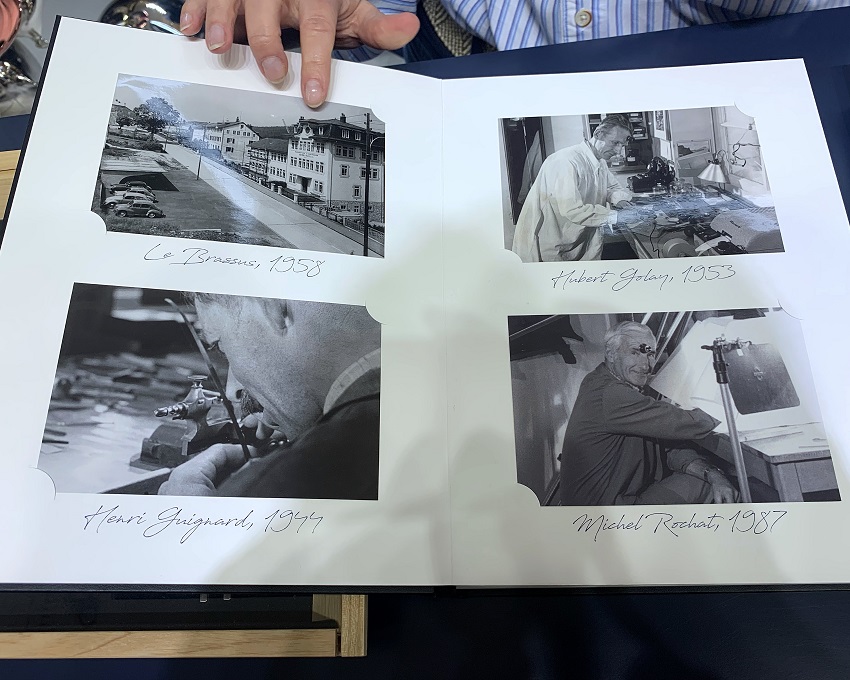
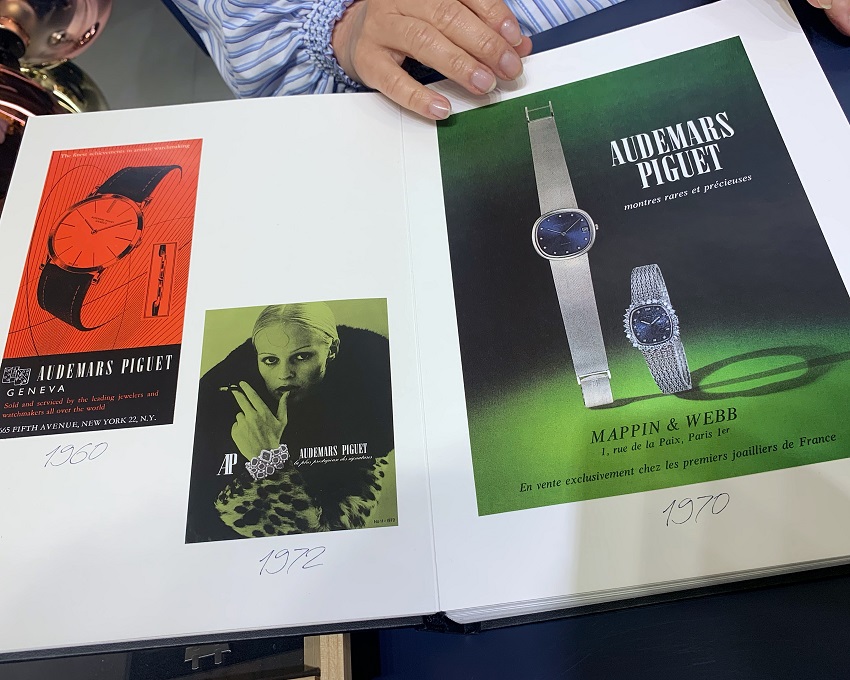
I love the history and stories behind watches, and the Royal Oak is one of the great stories, as I truly believe that these stories and other things like adverts and photos bring the past to life, evoking a sense of character and how the brand chose to portray their watches at the time.
With this all fresh in mind, we then got to have a closer look at some of the constituent parts of the Royal Oak, seeing how the case is constructed, as well some of the subtle differences in the original bracelet design versus the contemporary version.
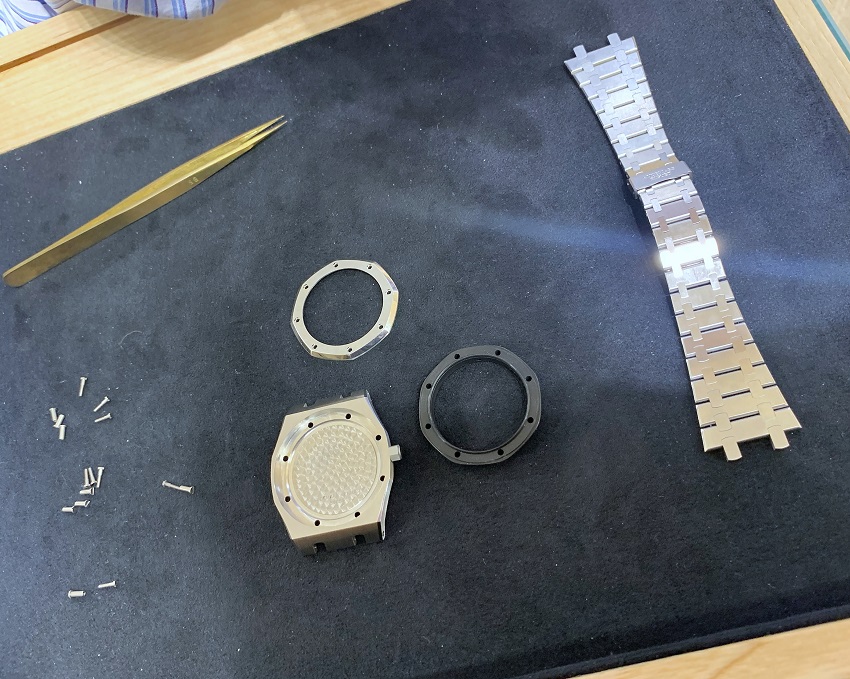
There were different examples of screws – some external ones which are used to hold the case together (a great way to see how the hexagonal screw-heads on the bezel are perfectly aligned), and a single suspiciously tiny screw as well.
This tiny screw was impressive enough on its own, but when the attendant explained that this was actually the biggest screw that goes into the watch movement, it certainly helped to put things into perspective. The watchmakers at Audemars Piguet train for two years, and the exacting high standards of the brand mean that these tiny, immaculately finished screws must be fitted perfectly, with no blemishes or marks.
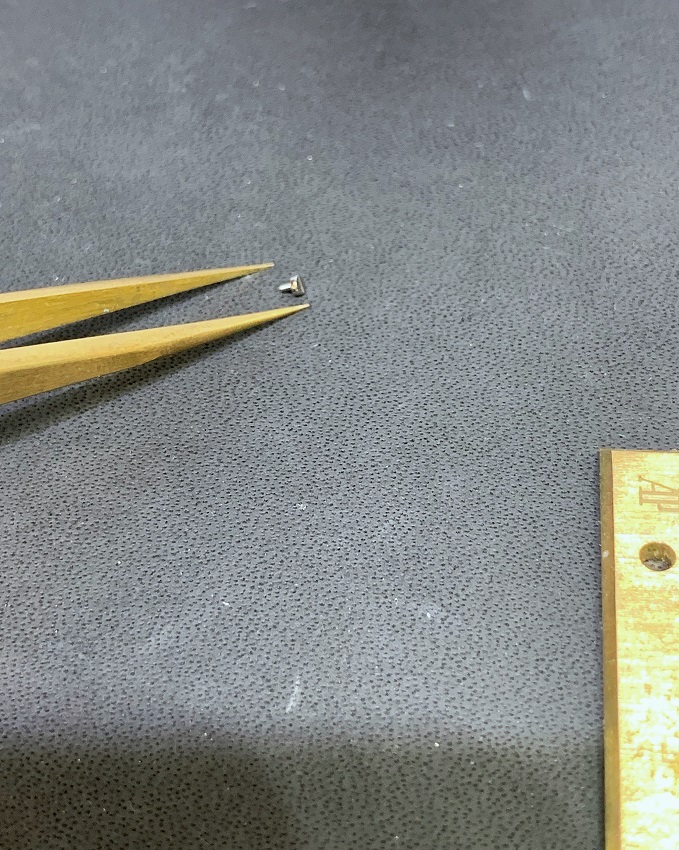
At which point we were invited to have a try at screwing one of these movement screws into a plate!
Walking us through the process, we first picked up the screw with a pair of tweezers using our dominant hand, before switching hands to hold the tweezers in our other hand. Using this hand, you gently place the screw into the hole, and then with your dominant hand you place the screwdriver head into the screw slot, being careful not to scratch it against the surfaces of the screw to leave any marks.
The screwdriver is held at the base between your thumb and middle finger, with your index finger resting atop the screwdriver to gently hold it in place. The process of turning the screw is done by twisting the screwdriver with your thumb and middle finger until the tension of the screw tightens.
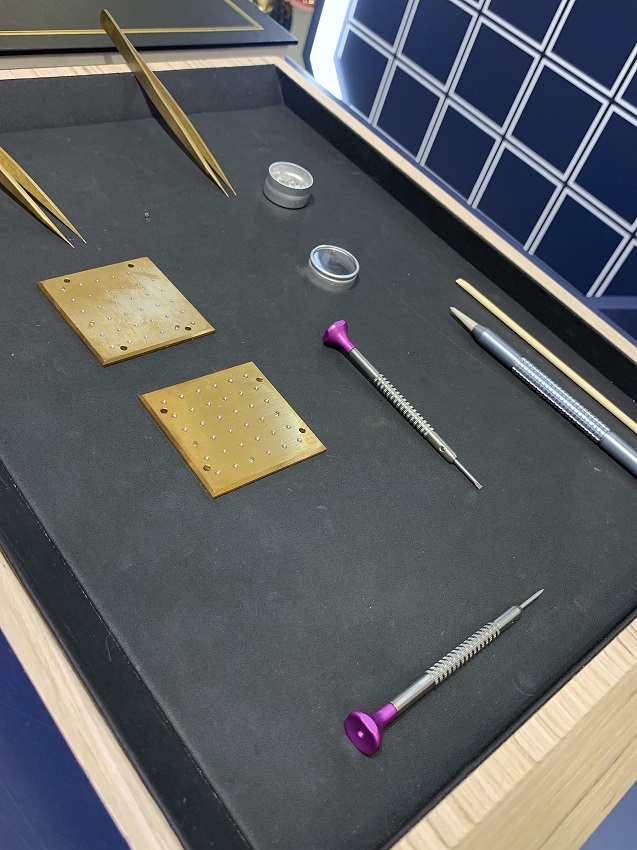
I thought I did a pretty good job (at least in so far as the screw didn’t go flying across the floor!) although I’m sure that under a loupe I probably butchered the screw somewhat. Either way, the attendant was kind enough to compliment my “skills”.
Finally, was the opportunity to have a go at applying the famous straight-brush finish that is found on the octagonal Royal Oak bezel. This is achieved by placing the bezel in the required orientation with the face down on abrasive diamond sandpaper, serving to both apply the straight-brush finish and also to get rid of any rough edges or burring on the edges of the bezel.
To apply the finish, you firmly press the bezel against the abrasive surface, and the trick is to then pull it towards yourself (as opposed to pushing it away) in a straight line, but not too quickly or slowly. At the end of this motion, you stop moving the bezel before picking it up vertically without knocking it as this can be detrimental to the finishing.
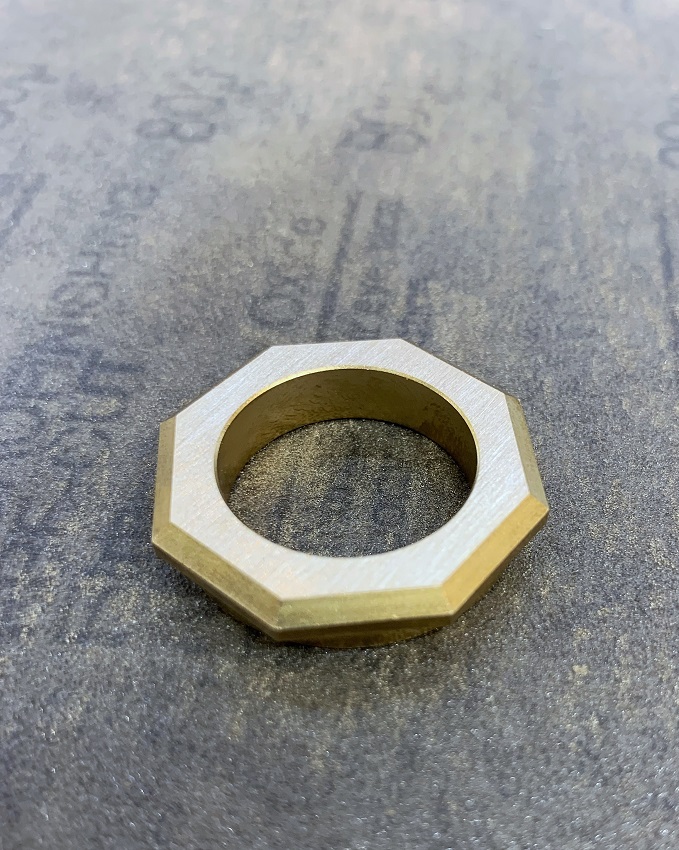
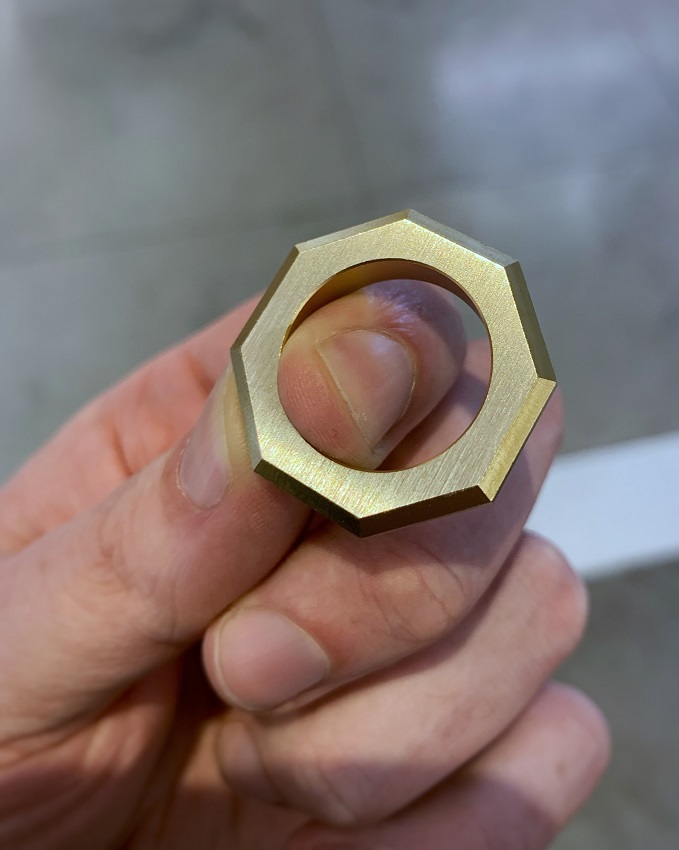
This took me several attempts to get the right level of finish applied and it is certainly a lot more involved than I had anticipated. As I left, I was quite pleased with my finished product, although again I am sure that whilst the attendant was complimentary that my work was somewhat sub-par!
In Summary
Obviously, milestone anniversaries such as this year’s 50th anniversary of the Royal Oak don’t come around very often. This was just a small part of the celebrations, but it was a part of them that is easy to get involved in and experience, and so I wanted to make the effort to attend.
The Royal Oak exhibit offered a chance to see some super rare watches that, in all likelihood, I am probably not going to see again. However, nothing beats hands-on experiences, and it was the unexpected opportunity to enjoy the album of advertisements and to also try my hand at handling the screw as well as applying the finish to the bezel (which also made a nice little take-away souvenir) which stood out to me as my favourite parts!
If you have any questions, please get in touch via our Contact page, or via our Instagram.
You might also be interested in:
- Phillips ‘Made in Germany’ A. Lange & Söhne Exhibition
- Jean-Claude Biver: A Retrospective, Share Respect Forgive
- Watch Finishing Techniques
- Watch Stationery and Gift Ideas
- Watch Books, Watch Boxes and more at the Watch Affinity Shop on Amazon (commissions earned)
As an Amazon Associate, I earn from qualifying purchases – thank you for your support

